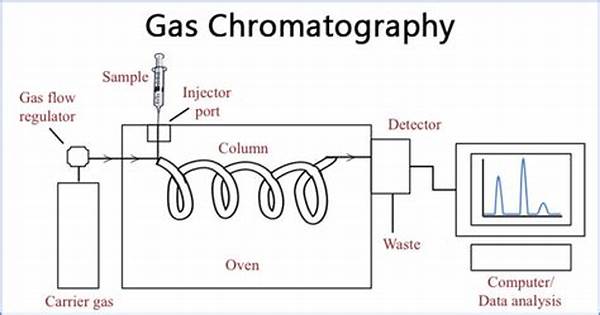Imagine being able to separate compounds like a magician, unveiling each molecule’s secrets with precision and artistry. Welcome to the world of gas chromatography (GC) — a magical portal into the molecular realm that has revolutionized the analytical chemistry landscape. No longer must scientists rely on intuition alone; instead, they stand armed with data as solid as the lab benches they work upon. Whether you’re a seasoned chemist keen to refine your craft, or a curious newcomer drawn by the call of discovery, understanding how to use a gas chromatography instrument promises to be an exciting journey.
Read More : How To Properly Use A Ph Meter
But why stop at dry technical explanations when you can have a narrative that pops with excitement, infuses humor, and offers engaging perspectives? With this dynamic guide, we will walk you through the ins and outs of GC with flair. Think of this as a tour through an analytical funhouse — insightful, educational, yet infused with wit and personality, leaving you not only informed but eager to apply your newfound knowledge.
Understanding Gas Chromatography Basics
Gas chromatography serves as a crucial tool in the realm of analytical chemistry, unlocking the mysteries of various compounds by separating and analyzing them with finesse. At the heart of achieving this feat is the gas chromatography instrument itself. This sophisticated device utilizes a carrier gas to transport your reluctant analyte through a column, where separation occurs — seamlessly offering up a profile of eluting compounds picked up by a detector.
The tale unfolds when your sample, introduced via an injection port, becomes part of this adventurous journey. With each compound emerging individually, deftly detected, and recorded as peaks on a chromatogram, you come face-to-face with the details nestled within the sample. It’s akin to translating a complex language, where each peak holds volumes of information about identity and quantity, accommodating a variety of industries from pharmaceuticals to environmental monitoring.
The Operational Steps of Gas Chromatography
Breaking down the steps of using a gas chromatography instrument, we delve into nuances that transform operational knowledge into analytical mastery. First, sample preparation serves as the foundation, ensuring precision from the onset. Inject your prepared sample into the instrument, entrusting it to the carrier gas, the unsung hero in our narrative — usually helium, nitrogen, or hydrogen.
Within the column, magic happens: compounds separate based on their interaction within the column and between phases, making their grand exit one by one. Peak detection is achieved using detectors like FID (Flame Ionization Detector) or MS (Mass Spectrometry), depending on specificity requirements. Capturing peak data extends this journey, as your chromatogram acts not merely as a registration of presence but a certificate of composition, waiting for your expert interpretation.
Tips for First-Time Users
New to the realm of gas chromatography? Fret not! The instrument may appear as daunting as a spaceship’s control panel, but the onboarding journey comes with essentials to ease you in. Begin with understanding instrument components — the carrier gas system, injector, column oven, detector, and data system. Each part sings together in an intricate symphony, and knowing your instrument is the first step toward mastering the melody.
Embrace the wealth of resources available, from manufacturers’ manuals to seasoned colleagues eager to share tips and anecdotes. Pilot-scale testing offers invaluable experiential learning, allowing you to pose questions, assess outcomes, refine techniques, and ultimately ascend toward proficiency. Your journey toward expertise demands perspicuity and patience, wrapped in curiosity and driven by pursuit of analytical truth.
Key Components of Gas Chromatography
The Role of Gas Chromatography Across Industries
Gas Chromatography holds an eminent position in the toolbox of many industries, adapting with versatility akin to a skilled multitasker engaged in a myriad of challenges. Consider the pharmaceutical industry, where GC ensures drug purity and monitors stability. It’s the invisible guardian that stands against impurities and degradation in sensitive compounds; a quality control sentinel.
Read More : How To Recognize The Quality Of Genuine Wood In Handmade Guitars
In environmental contexts, GC serves as a safeguard, distinguishing dangerous pollutants while assessing their concentrations within environmental media. Imagine tracing a chemical trail — a modern-day detective story — to ensure environmental integrity remains intact. Within food safety, gas chromatography steps as the noble steward, evaluating flavors and fragrances, sidestepping potential contaminants.
Advanced Applications and Troubleshooting
As your journey into gas chromatography continues, you may encounter hurdles where experience proves as vital as theory. It’s not merely about recognizing peaks; troubleshooting attests to your blend of insight and ingenuity.
Expanding into specialized applications leans on advanced detectors, like time-of-flight MS, diversifying your approach to complex matrices. Keeping abreast of technological advancements, engaging with latest research, these round out the comprehensive narrative of your growing expertise in gas chromatography.
Excel in Gas Chromatography
Mastering the art of gas chromatography is not merely understanding an instrument but appreciating it as an extension of your analytical arsenal. Your chromatogram reflects not only your proficiency but an ongoing dialogue between your scientific question and the tools at your disposal. Engaging in communities, sharing insights, learning collectively — these mutual exchanges enrich your analytical journey further.
In the tale of gas chromatography, your role embodies the inquisitive protagonist, balancing rational analysis with creative exploration. The story isn’t static; each analytical inquiry spins a new chapter, a narrative driven by data, reflective of both challenge and triumph. With a foundation infused with enthusiasm, diligence, and curiosity, mastering a gas chromatography instrument is less an endpoint and more a vibrant journey into the analytical unknown.
